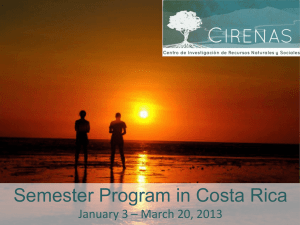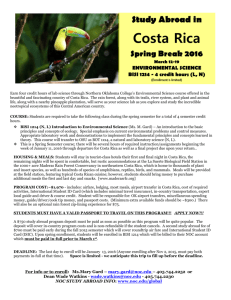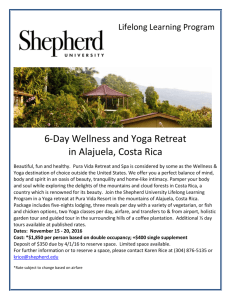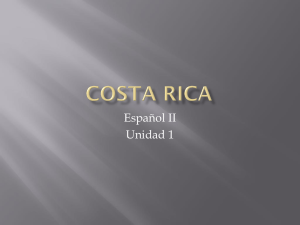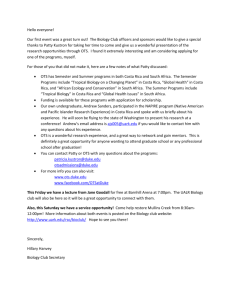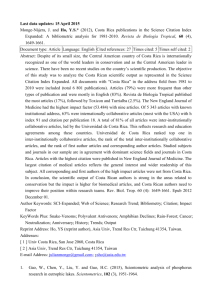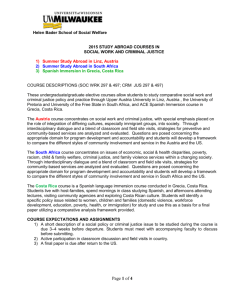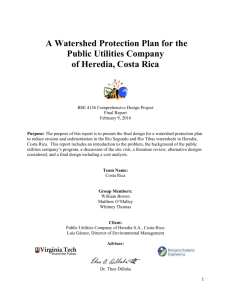here - Cirenas
advertisement
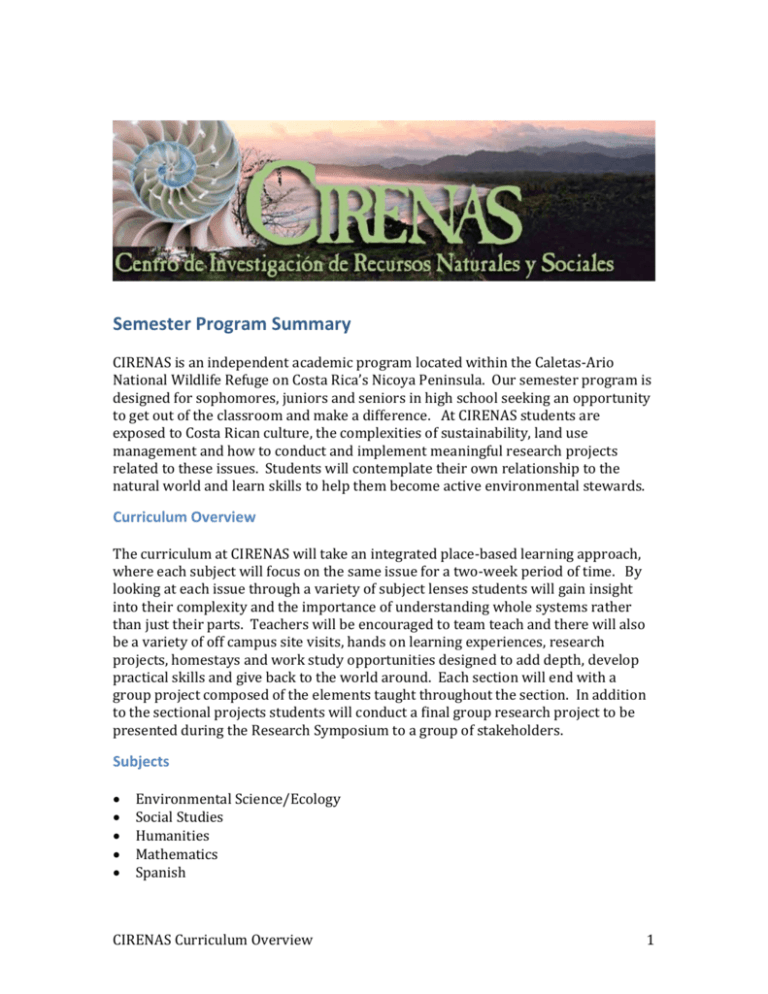
Semester Program Summary CIRENAS is an independent academic program located within the Caletas-Ario National Wildlife Refuge on Costa Rica’s Nicoya Peninsula. Our semester program is designed for sophomores, juniors and seniors in high school seeking an opportunity to get out of the classroom and make a difference. At CIRENAS students are exposed to Costa Rican culture, the complexities of sustainability, land use management and how to conduct and implement meaningful research projects related to these issues. Students will contemplate their own relationship to the natural world and learn skills to help them become active environmental stewards. Curriculum Overview The curriculum at CIRENAS will take an integrated place-based learning approach, where each subject will focus on the same issue for a two-week period of time. By looking at each issue through a variety of subject lenses students will gain insight into their complexity and the importance of understanding whole systems rather than just their parts. Teachers will be encouraged to team teach and there will also be a variety of off campus site visits, hands on learning experiences, research projects, homestays and work study opportunities designed to add depth, develop practical skills and give back to the world around. Each section will end with a group project composed of the elements taught throughout the section. In addition to the sectional projects students will conduct a final group research project to be presented during the Research Symposium to a group of stakeholders. Subjects Environmental Science/Ecology Social Studies Humanities Mathematics Spanish CIRENAS Curriculum Overview 1 Areas of Focus History and Culture of Costa Rica Watershed Studies Marine Ecosystems Sustainable Systems Research Symposium Semester One Calendar January 3rd – March 24, 2012 Arrival and Expedition – Jan. 3 – 10 January 3rd – Arrive in San Jose January 4th – Introductions, rules and expectations, teambuilding, sort gear January 5th – Travel to Karen Mogensen Reserve, hike to waterfalls and cabins January 6th – Tour of Reserve w/ guides, discussion about old growth forests January 7th – Hike to first campsite, flora and fauna ID along the way January 8th – Hike to Paquera transfer to Curu for kayaking January 9thth - Kayak from Curu Wildlife Refuge to Cabo Blanco, Travel to CIRENAS Sense of Place January 10th – 11th - Campus Tour, Horse Tour, Surf Lesson, Student Check Ins Section 1 – History and Culture of Costa Rica January 12th – 25th Section 2 – Marine Ecosystems January 26th – February 8th Community Service Event February 9th – 16th Section 3 – Watershed Studies February 17th – March 2 Section 4 – Agriculture and Sustainable Systems March 3rd – March 17th Research Symposium and Prep March 18th – March 21st - Symposium Preparation March 22nd - Research Symposium Departure March 23rd – Pack and leave for San Jose March 24th – Students depart CIRENAS Curriculum Overview 2 Subjects Environmental Science/Ecology The Caletas-Ario National Wildlife Refuge and Marine Protected Area will supply students and faculty with ample subject matter for ecological investigations. Students will study a variety of ecosystems including tropical dry forest, mangroves, coastal zones, marine areas, agricultural land, cloud forests and volcanoes. Fieldwork and research will be blended with fundamentals of ecological understanding and core concepts. All students will be taught how to conduct research, create a workable thesis, compile their results and most importantly take their research to the implementation phase. Social Studies The social studies curriculum at CIRENAS will be focused on people and their connection to the land. Students will start off looking back at the history of land use in Costa Rica and in particular the Nicoya Peninsula. Interviews and surveys will be combined with homestays, service learning projects and readings to offer wellrounded insight into the complex relationship that Costa Ricans have with their natural environment. Special focus will be given to agriculture, the fishing industry, development, US/CR relations, conservation and the rise of the ecotourism industry. Spanish The best way to learn a language is to live it. At CIRENAS our bilingual staff will interweave Spanish vocabulary and relevant verbs throughout their teaching. There will also be a specific Spanish class designed to address questions such as appropriate sentence structure, verb conjugations and local sayings. Time will be set aside each day as Spanish only time in which students will practice with each other, faculty, staff and the Costa Rican students. Certain projects will also require students to write and/or orally present their topic in Spanish, pairing up stronger Spanish speakers with beginners to serve as coaches. Humanities Artwork, scientific journaling, non-fiction writing and environmental literature will help students gain a more personal and well rounded understanding of Costa Rica, conservation, sustainability and our global community. Students will learn the importance of different writing styles and the complexity of communicating information to a variety of audiences and across disciplines. CIRENAS Curriculum Overview 3 Mathematics Our math curriculum will be similar to a high school probability and statistics course except that our students will in most cases be the data collectors. Students will be crunching data taken during field work and research projects as well as learning the importance of the quantitative evidence for supporting a thesis, providing measurable results and predicting outcomes. We will also look at the role that probability and statistics play in our daily lives, policy, media and research. Areas of Focus History and Culture of Costa Rica Costa Rica plays an interesting role in today’s world, known for both its conservation efforts and agricultural exports such as coffee, bananas and pineapples. Which rely heavily on agrochemicals for their production. Costa Rica is also known for its lack of a military and for having a larger middle class than most Central American countries. Students will learn about the evolution of “Central America’s Switzerland,” from its geological creation to present day. Coursework will be augmented by interviews, field trips to National Parks, visits to farms and indigenous reserves. Marine Ecosystems Bordered by both the Pacific and Caribbean Costa Rica has always had a strong connection to the ocean. Important for shipping and trade as well as both artisanal and commercial fishing the coastal waters of Costa Rica serve as the lifeblood for many Costa Ricans. In recent years however the fishing and shipping industries have come under closer scrutiny for their practices as tourism and conservation focused NGO’s have come to compete for this limited resource. Semester students will take part in Sea Turtle conservation efforts, interview commercial and artisanal fishermen, visit aquaculture projects, learn to surf, conduct tide pool investigations and study tourism related business ventures dependent on the ocean in order to gain perspective on this complex issue. Watershed Studies The Bongo Ario watershed where the CIRENAS campus is located is one of the most important watersheds on the Nicoya Peninsula. Currently AyA (Costa Rica’s National Water Company) is tapping into the Bongo-Ario aquifer to provide water to the rapid and unplanned developments of Santa Teresa and Mal Pais to the south. Students will study the central role that water plays in an area that has very distinct dry and rainy seasons, issues surrounding agriculture, development and deforestation and learn what restoration efforts can be taken in order to help conserve this essential resource for future generations. CIRENAS Curriculum Overview 4 Sustainable and Regenerative Systems The impacts of the petrochemical industrial revolution have taken an extreme toll on the earth’s environment. In order to be able to ensure a healthy, safe future for future generations active steps need to be taken towards not only sustainable but regenerative systems. Costa Rica has pledged to be the first carbon neutral country by 2020 and has long been host to a variety of incredible sustainability initiatives. Students will visit a few sustainability initiatives in order to provide examples of existing projects, inspire students and give them ideas to take back to the BongoArio watershed. During this section students will learn about whole systems design, permaculture techniques, evaluate and improve upon our sustainable systems at CIRENAS and design and construct various appropriate technologies to be used on campus and within the local communities. Activities and Opportunities At CIRENAS learning takes place in a variety of settings and circumstances. Our goal is to help students step out of their comfort zones by exposing them to new activities and various opportunities that will challenge them both mentally and physically. These challenges are designed to help students gain personal strength, learn new skills and accentuate their course content. Each student will gain a better understanding of their leadership style and how they interact within a team environment. Through teambuilding, sense of purpose and achievement students will form lifelong friendships built upon the knowledge that together they have made a positive impact on the world around them. List of Activities and Opportunities Horseback Riding Environmental Restoration Green Design Build Homestays Hiking Backpacking Kayaking CIRENAS Curriculum Overview Teaching English at Local Schools Surfing Yoga Ziplining Mountain Biking Work Studies Permaculture Projects 5 Student Evaluations Due to our small class sizes an emphasis will be made on thorough written evaluations as well as periodic personal check ins that give students a more well rounded understanding of their grades, progress and expectations. In addition to written evaluations each student will also be assigned an overall grade for each course to make the transference of all of their hard work easier for sending schools to integrate into their own systems. Students will also compile portfolios of the work that they accomplish while at CIRENAS to show to sending schools, parents and college admissions offices. Advisors will be assigned to each student in order to help them document their semester in a manner in which is truly reflective of that student’s unique experience. Skills on which students will be assessed Teamwork Due to the project oriented nature of many of our courses and close living quarters a large part of a student’s success at CIRENAS is dependent on their ability to work with others. Students will learn about their strengths and weaknesses in team environments, identify the roles in which they are typically the most comfortable and then asked to challenge themselves by taking upon roles in which they are less familiar. Creativity We are very interested in how a student is able to interpret information creatively and in a manner in which is appealing intellectually, artistically and to a variety of audiences. As the world continues to become more globalized we believe it is necessary for students to stand out, take chances and make their mark on the world around them. Problem Solving Our goal is to create active problem solvers equipped with the skills and mindset that there is always a solution. Students are encouraged to think outside of the box in order to create new ideas, strategies and innovations. Real World Application At CIRENAS the beauty of the Caletas-Ario National Wildlife Refuge and surrounding communities is our classroom. Students are assigned traditional reading and writing assignments but the true test will always be how it is applied to the world around us. We place great value on action and transitioning subject material into real world scenarios. CIRENAS Curriculum Overview 6



